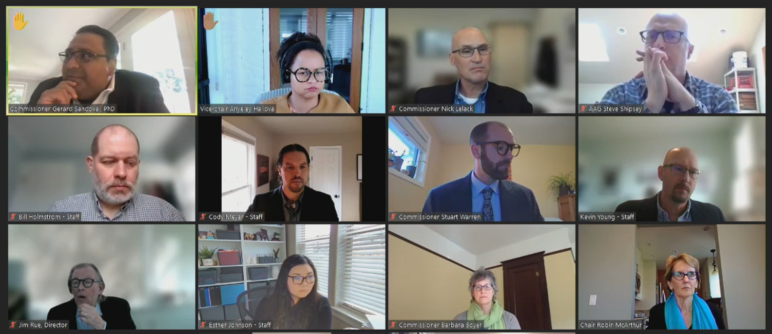Oregon Nears Green Light for Big Parking Reform
This article was originally published on Sightline Institute, and is shared here with permission. All images for this piece were provided by the author, unless otherwise indicated.
Walmart in Wood Village, Oregon.
Oregon’s statewide land use board declared its support Thursday for rules that, among other things, reduce or remove parking mandates in 53 jurisdictions in the state’s eight largest metro areas.
But the board stopped short of permanently approving the full package as written, instead voting unanimously to temporarily adopt the rules, a major update to state land use standards more than two years in the making.
“I think we’re 98 percent there,” said Land Conservation and Development Commission Vice Chair Anyeley Hallova, who will move into the chair position of the governor-appointed board at its next meeting in July.
Commissioner Nick Lelack, who proposed the two-month slowdown, expressed support for the package but wanted more time to hear specific concerns on particular issues. He said he was responding in part to a letter received the previous night, in which 29 mayors from around the state had urged delay.
“I want to be genuine in listening to people that we have just heard from for the first time,” he said. “The process isn’t complete.”
In order to have time to more fully address local jurisdictions’ concerns, the commission set a deadline of July 1 for future comments.
Members and staff of Oregon’s Land Use and Development Commission.
“A Chance To Do So Much Good for Free”
Lelack’s stated concern wasn’t with the parking components of the proposal, which he’d singled out for particular praise at the commission’s previous meeting.
“It’s pro-housing, pro-equity, pro-efficient-land-use,” Lelack said. “It addresses all the key issues we needed to address.”
Most of the oral testimony the board received in Thursday’s three-hour public hearing was similarly supportive: 32 testifiers generally in favor of the reform package and 19 opposed.
Parking mandates aren’t the main reason we have parking lots. We have parking lots because cars are useful and, in many cases, necessary. And Oregon isn’t considering a ban on parking lots, new or old.
But the effect of mandatory parking lots is to keep cars necessary. By forcing buildings apart and driving up the cost of adding homes, shops, and offices to walkable areas, parking mandates make it illegal for cities to ever gradually and voluntarily evolve away from auto dependence.
Parking mandates ban new Main Streets by requiring each new 2,000-square-foot café to be surrounded by 5,000 square feet of parking lot. They keep buildings vacant. They drive up the rent in new apartments by hundreds of dollars a month and kill the incentive of landlords and employers to save everyone money by coordinating shared cars or discounted transit passes. They induce deadly heat islands and, by forcing new buildings to be spread out, literally cast modern auto dependence into stone.
Transportation advocate and city planning consultant Cathy Tuttle was among those speaking Thursday in favor of removing parking mandates.
“The beauty of these administrative changes to eliminate parking mandates is that they’re easy to implement, and have the potential to do good without costing the state or the cities much money,” Tuttle said. “Rarely do we get a chance to do so much good for free.”
“It Gives Me a Stress Attack”
Parking was also on the minds of various local officials who spoke in opposition.
“Since I’ve been on council for 10 years now, I can sum up in three words some of the most important issues: parking, parking, parking,” Eugene City Councilor Claire Syrett told the commission. “It is a huge topic that you don’t expect when you join city council. … Frankly, as an elected official it gives me a stress attack to think about how we’re going to deal with this in terms of public engagement.”
In a state with soaring rents and sale prices, a state-estimated shortage of 111,000 homes, and one of the highest rates of homelessness in the U.S., the rules would increase the number of new homes, shops and offices that can be built without mandates for a certain number of parking spaces on site in the state’s eight largest metros.
For small homes, homes meeting affordability standards, and buildings near transit service, the number of on-site parking spaces would become fully flexible by the start of 2023.
Happy Valley Councilor Brett Sherman spoke from a suburban city where the median income of $125,000 is among Oregon’s highest. He cited one new building with 168 homes and 301 parking stalls, warning that the new rules would have allowed it to be built with as few as 84 stalls.
“The parking lots are currently 80 percent full at night,” Sherman said.
Hallova replied that the commission isn’t preventing the construction of parking lots, and that in her own developments she has included on-site parking even when it isn’t required, because she knew that she would struggle to find buyers without it.
A different testifier, Paul Frazier, argued that Sherman’s own example was of a parking lot that had been overbuilt.
“That means there’s 20 percent too many,” Frazier said. “Right now we provide an abundance of supply regardless of the demand.”
The Milwaukie Cafe and Bottle Shop operates out of an old building that likely predates parking mandates. Customers often park along nearby curbs, arrive by bus, or walk.
Part of a Complex Reform Package
One of several local officials testifying in favor of the rules was Milwaukie Mayor Mark Gamba.
“I know that some cities feel like this is a big lift,” Gamba said. “I can tell you that Milwaukie does not feel that way, in large part due to the fact that we’ve been doing much of this work since I took office seven years ago. Because everything in here is just the common-sense changes that every city everywhere should be doing at a minimum.”
In addition to the parking reforms, the rules would raise state standards for bikeway and walkway design and limit the amount of additional driving per person that cities’ transportation investments would be expected to induce. Within “climate-friendly areas” that each jurisdiction would be required to designate, the rules would also allow up to four-story buildings. And the rules impose various other design requirements, such as preventing cars from circulating between the sidewalk and buildings and requiring a particular standard of maintenance for trees in large parking lots, to reduce heat islands.
Ariel Nelson, of the Oregon League of Cities, said it’s those fine details that her members are asking for more time to review. The broad reach of the changes had city leaders concerned about their own administrative capacity for local public engagement and implementation. The commission repeatedly heard requests for more financial support for local jurisdictions.
“We are asking for a delay in the rules—not a long one, not forever, not a delay for the sake of delay—but to continue working on addressing the pages of testimony, the unresolved issues, that cities have raised,” Nelson said.
That wish was essentially granted, in a limited way, by the land use commission on Thursday.
“The commission, it sounded like, wanted to engage with interested parties to add some clarity and make some minor adjustments that supported the overall intent and direction of the rules,” state land use planner Evan Manvel said in an interview Friday.
Mary Kyle McCurdy, deputy director at the anti-sprawl group 1000 Friends of Oregon, said Friday that calls to avoid or delay the rules are also endorsements of Oregon’s status quo.
“Today’s land use and transportation plans are not meeting housing and transportation equity; delay just perpetuates inequitable plans,” she said. “Some local governments asking for delay say they know what to do. But they haven’t been doing it for 30 years, even though reducing [driving] through land use and transportation planning has been a requirement for three decades. Except for Metro, local governments and [metropolitan planning organizations] have fallen way short. They know what to do, but they’re not doing it enough.”
Michael Andersen covers housing and transportation for Sightline Institute, the Pacific Northwest's sustainability think tank. He previously wrote about those issues for 10 years as a journalist in Oregon and Washington.




